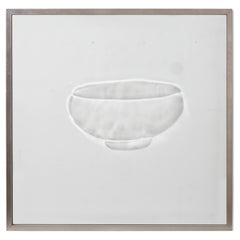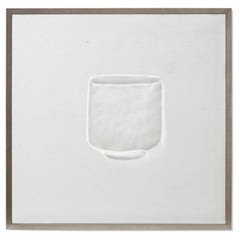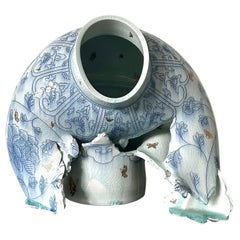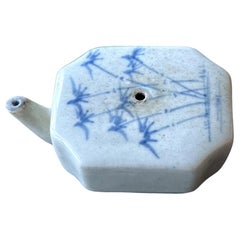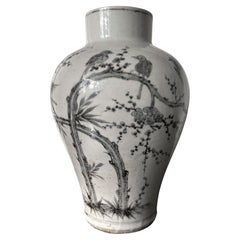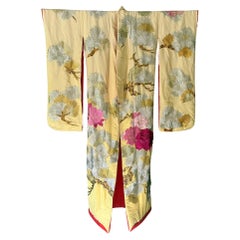TISHU Asian Art and Furniture
to
8
671
730
630
41
56
9
2
1
121
276
233
41
128
39
24
22
3
7
8
7
5
2
1
2
4
242
240
150
109
95
635
602
340
151
105
671
671
671
27
14
11
10
7
Item Ships From: Atlanta
Korean Etched Glass Sculpture by Sang-Min Lee
Located in Atlanta, GA
Sang-Min Lee
Title: Black Glazed Bowl
Year: 2018
Engraved glass in artist's frame
Etched signature and year on the lower right corner
Provenance: Gallery Tableau, South Korea
Priva...
Category
2010s South Korean Modern Sculptures and Carvings
Materials
Glass
Korean Etched Glass Sculpture by Sang-Min Lee
Located in Atlanta, GA
Sang-Min Lee
Title: Celadon Cup
Year: 2018
engraved glass in artist's frame
Etched signature and year
Provenance: Gallery Tableau, South Korea
Private collection in US.
The piece i...
Category
2010s South Korean Modern Sculptures and Carvings
Materials
Glass
Contemporary Ceramic Sculpture Deconstructed Vase by Steven Young Lee
Located in Atlanta, GA
A bespoken ceramic sculpture made by American Korean artist Steven Young Lee (1975-) circa 2010s. Inspired by the antique blue and white porcelain jar from Joseon Dynasty, the piece ...
Category
2010s American Post-Modern Ceramics
Materials
Ceramic
Korean Ceramic White Porcelain Water Dropper Joseon Dynasty
Located in Atlanta, GA
A small Korean water dropper in rectangular form with beveled edges, circa early 19th century of the Joseon Dynasty. The milky white porcelain pie...
Category
Antique 19th Century Korean Other Ceramics
Materials
Ceramic
Large Korean Ceramic Jar Joseon Dynasty
Located in Atlanta, GA
A large Korean white porcelain jar with underglaze decoration circa late 19th century of Joseon Dynasty. The vase has a well-proportioned profile of a classic jar (known as Hangari in Korean and was being produced since 18th century from Punwon-ri Kilns) with a tall upright neck that extends to a generous opening and swelled rounded shoulder that tapers down toward the base. Many of these porcelain jars were decorated with underglaze cobalt blue painting...
Category
Antique 19th Century Korean Other Ceramics
Materials
Ceramic
Vintage Japanese Ceremonial Wedding Kimono with Embroidery Designs
Located in Atlanta, GA
A large Japanese Wedding Kimono with bold embroidery designs. The auspicious attire was known as Uchikake and was worn by the bride during the wedding ceremony made from silk and hea...
Category
Early 20th Century Japanese Japonisme Textiles
Materials
Brocade, Silk
Exquisite Japanese Lacquer Maki-e Hand Box Kobako Edo Period
Located in Atlanta, GA
An early Japanese lacquer Maki-e decorated kobako (small storage box) circa 18th century (Edo period). Based on its form and size, this kobako was possibly used as a Chabako to store the accoutrements for chado (tea ceremony). The lidded box is of rectangular form with bevel design on all edge that softens the appearance. The entire surface was densely covered with a background of nashiji. Elaborate Maki-e techniques were used on each side to showcase a distinct landscape or floral design within a cartouche panel. On the surface of the lid, a mountainous landscape rises from the edge of the water. The poetic composition is akin to a traditional ink scroll...
Category
Antique 18th Century Japanese Edo Lacquer
Materials
Lacquer
Ceramic Tea Bowl with Brilliant Red Glaze by Toshiko Takaezu
By Toshiko Takaezu
Located in Atlanta, GA
A glazed ceramic tea bowl (chawan) by Japanese American artist Toshiko Takaezu (American, 1922 - 2011). The hand-built form shows slight irregularity and is covered with a brilliant ...
Category
1990s American Modern Decorative Bowls
Materials
Ceramic
Ceramic Tea Bowl with Mottled Yellow Glaze by Toshiko Takaezu
By Toshiko Takaezu
Located in Atlanta, GA
A glazed ceramic tea bowl (chawan) by Japanese American artist Toshiko Takaezu (American, 1922 - 2011). The hand-built bowl is covered with a striking matte glaze in mustard yellow w...
Category
Vintage 1980s American Modern Decorative Bowls
Materials
Ceramic
Korean Celadon Ritual Incense Burner Joseon Dynasty
Located in Atlanta, GA
An antique Korean ritual incense burner circa 19th century (late Joseon dynasty). This type of porcelain incense burner was made in Bunwon Kiln in Gwangju, Gyeonggi Do, near Seoul. U...
Category
Antique 19th Century Korean Archaistic Ceramics
Materials
Ceramic
Fine Korean Box with Tray Iron with Silver Inlay Joseon Dynasty
Located in Atlanta, GA
A fine Korean iron box with intricate silver inlay dated to the late Joseon Dynasty circa 19th century. The body of the box is made from iron of a heavy weight although the wear on t...
Category
Antique 19th Century Korean Other Metalwork
Materials
Silver, Iron
Japanese Bronze Statue Nyoirin Kannon on Lotus Throne
Located in Atlanta, GA
A small and fine Japanese bronze statue of Nyoirin Kannon circa 18th century of Edo period. Kannon is bodhisattva of Mercy and Compassion (Avalo...
Category
Antique 18th Century Japanese Edo Sculptures and Carvings
Materials
Bronze
Fine Japanese Hibachi Lacquer with Inlays Meiji Period
Located in Atlanta, GA
A fine Japanese wood Hibachi with copper insert circa 1900-30s end of Meiji to Taisho Period. It can be used as a unique planter or to showcase a...
Category
Early 20th Century Japanese Meiji Lacquer
Materials
Copper
Antique Chinese Kesi Fourth Rank Badges Qing Dynasty
Located in Atlanta, GA
A fine silk kesi civil rank badge panel (known in Chinese as Buzi) framed and glazed. The fourth rank panel feature borders of fret archaic key and are cente...
Category
Antique 19th Century Chinese Qing Textiles
Materials
Silk, Giltwood
Antique Burmese Lacquer and Gilt Buddha Head Sculpture
Located in Atlanta, GA
An antique lacquered and gilt wood buddha head on a custom wood stand circa early 19th century. The statue was finely sculpted with a wood core and th...
Category
Antique Early 19th Century Burmese Archaistic Sculptures and Carvings
Materials
Lacquer, Wood
Ceramic Sculpture by South Korean Artist Jongiin Park
By Jongjin Park
Located in Atlanta, GA
A highly unique ceramic sculpture by South Korean artist Jongjin Park (1982-). The square-form piece is boundary-pushing and defies both the traditional ...
Category
2010s South Korean Organic Modern Ceramics
Materials
Ceramic, Paper
Large Korean Head Side Chest Morijang Joseon Dynasty
Located in Atlanta, GA
A finely crafted Korean Morijang chest dated to the late 19th century toward the end of Joseon Dynasty. "Morijang" was traditionally used to keep house valuables such as jewelries an...
Category
Antique Late 19th Century Korean Other Furniture
Materials
Brass
Fine Antique Korean Bandaji Chest Gyeonggi Do Joseon Dynasty
Located in Atlanta, GA
A Korean Bandaji Chest circa late 19th century (toward the end of Joseon Dynasty). Bandaji is known as drop-front half opening chest and was traditionally used to store household val...
Category
Antique Late 19th Century Korean Other Furniture
Materials
Brass
Antique Korean Buncheong Flat Bottle Vase with Incised Designs
Located in Atlanta, GA
A Korean Buncheong stoneware vase circa 15th century of Joseon Dynasty. The robust vase with thick walls was made in a bottle form with rounded square contour and flattened surfaces....
Category
Antique 15th Century and Earlier Korean Archaistic Ceramics
Materials
Ceramic
Japanese Wireless Musen Cloisonne Vase by Ando Jubei
By Ando Jubei
Located in Atlanta, GA
A Japanese cloisonne vase in bottle-form made by Ando Jubei (1876-1963) circa 1910-20s (late Meiji to Taisho period). The vase features a completely smooth surface without showing any wire. The technique is known as Musen (hidden wire) in Japanese and was notoriously difficult to perfect, especially with piece like this with a relatively large continuous surface. The beguiling effect is to use enamel to mimic porcelain or even jade. This vase, with its ultra smooth surface and soft yellow color (Yellow was often associated with Japanese imperial household...
Category
Early 20th Century Japanese Meiji Metalwork
Materials
Silver, Enamel
Japanese Bamboo Art Sculpture Kawashima Shigeo Soul's Trance
Located in Atlanta, GA
A contemporary bamboo sculpture art pieces by Japanese artist Kawashima Shigeo (1958-). Entitled
"Soul's Trace", this bespoken piece was made in 2009 and purchased from Tai Modern, ...
Category
Early 2000s Japanese Modern Sculptures and Carvings
Materials
Bamboo, Thread
Magnificent Antique Japanese Woven Brocade Kesa Monk's Robe Meiji Period
Located in Atlanta, GA
A stunning Japanese Kesa (Monk's Vestment) made from thirteen columns of patchworks of shimmering woven brocades with luxuriant golden threads. Dated to late 19th century of Meiji Period, the elaborate woven motifs on this kesa feature repetitive roundels dragon and phoenix intermixed with peonies and chrysanthemum blossoms. Two shades of contrasting gold threads were used on a striking purplish-blue background, with a dark metallic thread for the outer border and a brighter thread for the main body. The brilliantly woven fabric was possibly recycled from Noh costumes...
Category
Antique Late 19th Century Japanese Meiji Textiles
Materials
Brocade, Silk
Antique Japanese Embroidered Silk Kesa Monk's Robe Edo Period
Located in Atlanta, GA
A Japanese Kesa (Monk's Vestment) made from thirteen columns of patchworks of fine shimmering silk fabric of a salmon orange color, the shade of which changed subtly from different a...
Category
Antique 19th Century Japanese Edo Textiles
Materials
Brocade, Silk
Rare Korean Water Dropper in Doughnut Form Joseon Dynasty
Located in Atlanta, GA
A Korean blue and white porcelain water dropper in a rare hallowed out doughnut shape from Joseon Dynasty circa 1800s. The octagonal water droppe...
Category
Antique Late 18th Century Korean Other Ceramics
Materials
Ceramic
Korean Ceramic Faceted Blue and White Bottle Vase Joseon Dynasty
Located in Atlanta, GA
A Korean blue and white long neck vase in bottle form with octagonal faceted surface from Joseon Dynasty (19th century). The elegant vase is cove...
Category
Antique 19th Century Korean Archaistic Ceramics
Materials
Ceramic
Early Tall Ceramic Vase with Unique Glaze by Brother Thomas Bezanson
By Brother Thomas Bezanson
Located in Atlanta, GA
An early ceramic vase in a cylinder form by potter Brother Thomas Bezanson (1929-2007). Unusually tall at 21.75 inches, the vase strikes the viewer with its slender silouette with a tapering neck and mouth opening. What is extraordinary about this piece is the complex glaze Bezanson applied on the surface. Three vertical black glaze stripes are featured around the surface. On one side, stacks of horizontal finger-like marks were placed on a brown and silvery iridescent background, characterized as "Honan tenmoku" glaze. The other side, the glaze took on a brilliant silver oxidation in a mottled effect. The top conical portion is largely covered with a thick and oily "black olive" glaze, which is dripping down in high saturation. Circles surrounding the rim was less iron-saturated, forming a more orderly visual border. In close range, the different glazes across the vase displays subtle changes of shimmering, iridescent and textured effects and are visually mesmerizing.
Bezanson's ceramic and glaze techniques was rooted in Asian ceramic tradition but utterly modern looking.
The vase was marked on the base "Benedictine Monks Weston Vermont", "^60 BRENER" and Bezanson's decipher as shown. The decipher indicated that this vase was made in Weston VT circa 1965-1970, same period of another vase with similar glaze effect in our gallery (shown in the last photo), showcasing the highly sophisticated techniques Bezanson mastered and used fluidly in his ceramic work.
Brother Thomas Bezanson (1929-2007) was a Canadian born artist and Benedictine monk primarily known for his porcelain pottery and mastery of complex glazes. Strongly influenced by Asian pottery, often adapting traditional Chinese and Japanese pottery methods and materials to his work. He is renowned for his original glaze recipes and perfect forms and always sought to create something new and beautiful. His exacting standards made for the shattering of over 80% of each firing. One "rescued" piece however is now in the collection of the Museum of Fine Arts, Boston. His estate is represented by Pucker Gallery...
Category
Mid-20th Century American Modern Vases
Materials
Ceramic
Fine Antique Korean Ceramic Water Dropper Joseon Dynasty
Located in Atlanta, GA
A fine porcelain water dropper from Korea circa 19th century of the late Joseon Dynasty. Water dropper is one of the essential scholar objects in the Confucius Joseon society where ink calligraphy was considered an important cultivation of an educated man. The water dropper is a small contained made to drop the water onto the ink stone to grind the ink stick for writing. These miniature objects were made in various forms as little wonders as a desktop accessory for the Scholar's study.
The water dropper on offer was made of porcelain and covered in a grey celadon glaze. It was molded in the form of a beach with finely sculpted stalk and leaves. A slight red was dotted on the two openings. The surface also has a carved grape or pomegranate motifs under the glaze. There is some slightly running of the celadon glaze on top. The base has residues of kiln grits.
Although the peach form was perhaps one of the most common ones among the Korean water droppers...
Category
Antique Early 19th Century Korean Other Scholar's Objects
Materials
Ceramic
Korean Headside Storage Cabinet Morijang Joseon Dynasty
Located in Atlanta, GA
A small Korean wood cabinet dated to the late Joseon Dynasty circa 19th century. The cabinet was known as "Morijang" in Korean and was traditionally used to keep valuables such as je...
Category
Antique 19th Century Korean Other Furniture
Materials
Brass
Antique Korean Small Table Soban Gangwon Do Joseon Dynasty
Located in Atlanta, GA
A small rectangular wood table from Korea circa late 19th century of Joseon Dynasty. Known as Soban (small plate), this type of light weight table was used primarily as individual dining...
Category
Antique Late 19th Century Korean Other Furniture
Materials
Wood
Fine Japanese Portable Tea Cabinet Meiji Period with Provenance
Located in Atlanta, GA
An antique Japanese portable cabinet finely fashioned out of Sandalwood, a fragrant and also one of the most expensive woods that was used to make small luxury pieces. The handled ca...
Category
Early 20th Century Japanese Meiji Furniture
Materials
Wood, Sandalwood
Antique Large Japanese Futon Cover with Resist Yuzen Dye
Located in Atlanta, GA
A large unframed Japanese Futonji textile art circa late 19th century toward the end of the Meiji period. Seamed together from four vertical sections of cotton in deep indigo color, ...
Category
Antique 1890s Japanese Meiji Textiles
Materials
Cotton
Large Japanese Textile Futon Cover with Resist Yuzen Dye
Located in Atlanta, GA
A large unframed Japanese textile art circa late early 20th century toward the end of the Meiji period. Seamed together from four vertical sections of cotton in deep indigo color, th...
Category
Early 20th Century Japanese Meiji Textiles
Materials
Cotton
Japanese Textile Panel Double Ikat Kasuri Futon Cover
Located in Atlanta, GA
A Japanese woven cotton textile panel with white pattern on indigo background circa 1900-20s (end of Meiji to Tasho period). The panel was joined by four vertical stripes and was tra...
Category
Early 20th Century Japanese Meiji Textiles
Materials
Cotton
Japanese Textile Panel Double Ikat Kasuri Futon Cover
Located in Atlanta, GA
A Japanese woven cotton textile panel with white pattern on indigo background circa 1900-20s (end of Meiji to Tasho period). The panel was joined by four vertical stripes and was tra...
Category
Early 20th Century Japanese Meiji Textiles
Materials
Cotton
Pair of Small Korean Celadon Inlay Vases Goryeo Dynasty
Located in Atlanta, GA
On offer is a near pair antique Korean ceramic vase from the end of Goryeo to the beginning of Joseon period (circa 14-15th). The vases feature cel...
Category
Antique 15th Century and Earlier Korean Archaistic Ceramics
Materials
Ceramic
Antique Korean Porcelain Jar with Pheonix Design Joseon Dynasty
Located in Atlanta, GA
A korean white porcelain jar with underglaze blue paint circa late 19th century toward the end of Joseon Dynasty. Porcelain jars of this elongated form with swell shoulder, wide mout...
Category
Antique Late 19th Century Other Ceramics
Materials
Porcelain
Fine Korean Porcelain Jar with Chrysanthemum Design Joseon Dynasty
Located in Atlanta, GA
A fine Korean white porcelain jar with underglaze blue painting circa second half of 19th century, Joseon Dynasty. Considered associated with Punwon-ri kilns in Gwangju, these types ...
Category
Antique Late 19th Century Korean Other Ceramics
Materials
Porcelain
Antique Korean Porcelain Peony Jar Joseon Dynasty
Located in Atlanta, GA
A Korean white porcelain jar with underglaze blue painting of large peonies with leaves circa second half of 19th century, Joseon Dynasty. Considered associated with Punwon-ri kilns ...
Category
Antique Late 19th Century Korean Other Ceramics
Materials
Porcelain
Antique Korean Porcelain Peony Jar Joseon Dynasty
Located in Atlanta, GA
A Korean white porcelain jar with underglaze blue painting of large peonies with leaves circa second half of 19th century, Joseon Dynasty. Considered associated with Punwon-ri kilns ...
Category
Antique Late 19th Century Korean Other Ceramics
Materials
Porcelain
Fine Antique Tall Korean Medicine Chest Yakchang Provenance
Located in Atlanta, GA
A fine antique Korean medicine or apothecary chest from late Joseon Dynasty (circa 19th century). Known as Yakchang in Korean, this type of chest was used to sort and store herb medicines in its many small drawers. The prototype was originated in China, but this piece is distinctively Korean. The fine piece was made from Paulownia wood, which has an insect-repelling quality. Relatively tall, the Yakchang features a slightly overhanging and upturning pagoda plank top. The upper part has ten rows of smaller drawers, eight per row and eighty total. The lower part is centered with double doors with brass hinges and pull that open to a small storage space, which is surrounded by twelve larger drawers. Each drawer is fitted with yellow brass pulls and with two names of the herbs in gilt Hanja writings.
Examination of the construction and patina shows that this is an authentic antique piece that has seen extensive historical use. Provenance: Purchase from Lucky-Chosun Furniture, Seoul, Korea in 1986 and remains in an American collection until now. With an original invoice and also a freight invoice from Korea to Hongkong. There is also an insurance appraised by Sotheby's from 1997.
A tall medicine chest with similar configuration from a doctor's home in Yongin Folk Village is illustrated on plate 75 page 61 in the book "Korean Furniture and Culture" by Bokcha, Soon and Youngsoon.
To compare with another Medicine Chest, see illustration on page 47 in "Korean Antique Furniture...
Category
Antique 19th Century Korean Other Furniture
Materials
Brass
Japanese Art Deco Ikat Silk Meisen Kimono
Located in Atlanta, GA
A well preserved Japanese Meisen kimono hand-sewn from woven Ikat Silk circa 1920-30s (Taisho to early Showa period). The kosode style kimono (small slee...
Category
Early 20th Century Japanese Showa Textiles
Materials
Silk
Japanese Art Deco Ikat Silk Meisen Kimono
Located in Atlanta, GA
A well preserved Japanese Meisen kimono hand-sewn from woven Ikat Silk circa 1920-30s (Taisho to early Showa period). The kosode style kimono (small slee...
Category
Early 20th Century Japanese Showa Textiles
Materials
Silk
Antique Chinese Scholar Rock Yingde Stone on Display Stand
Located in Atlanta, GA
An intriguing Chinese scholar rock in vertical form presented on a custom hand-carved wood stand circa late Qing Dynasty. The greyish black stone is of Yingde type. Its upright form ...
Category
Antique 19th Century Chinese Qing Scholar's Objects
Materials
Stone
Chinese Lingbi Scholar Stone Arched Form on Display Stand
Located in Atlanta, GA
A small desk top Chinese scholar stones (also known as Gong Shi, meditation stone and spirit rock) fitted on a hand-carved wood stand circa late 19th century. The specimen is of a black Lingbi type stone in an arch form mimicking a horizontal mountain range. The wrinkles and folds on the black surface were perfectly weathered by elements for millenniums. Smooth and rugged at the same time, the mountain range shows a poetic formation that was often depicted in the ink scroll...
Category
Antique 19th Century Chinese Qing Scholar's Objects
Materials
Stone
Antique Korean Lacquer Wood Soban Table Joseon Period
Located in Atlanta, GA
An antique wood table from Korea from late 19th century (end of Joseon Dynasty). This type of light weight table is called "Soban" in Korean. which means "Small Tray". It was widely used primarily as individual dining table to present and serve foods, but also as small desk, incense burner holder...
Category
Antique Late 19th Century Korean Other Furniture
Materials
Wood
Antique Korean Lacquer Wood Soban Table Joseon Period
Located in Atlanta, GA
A small antique wood table from Korea from turn of the 20th century (end of Joseon Dynasty). This type of light weight table is called "Soban" in Korean. which means "Small Tray". It was widely used primarily as individual dining table to present and serve foods, but also as small desk, incense burner...
Category
Antique Late 19th Century Korean Other Furniture
Materials
Wood
Pair of Fine Miniature Satsuma Vase with Moriage Enamel Decoration by Seikozan
Located in Atlanta, GA
A pair of small ceramic vases with superb surface decorations made by Japanese studio Seikozan circa 1890-1910s (late Meiji Period). One of the many artist studios that specialized i...
Category
Antique 1890s Japanese Meiji Ceramics
Materials
Ceramic
Antique Japanese Lacquer and Inlay Table from Ryukyu Islands
Located in Atlanta, GA
A small square-form table with lacquer and intricate mother-of-pearl inlay design from Ryukyu Islands kingdom circa 17-18th century. Ryukyuan kingdom was used to be an independent is...
Category
Antique 18th Century Japanese Edo Lacquer
Materials
Mother-of-Pearl, Lacquer
Antique Japanese Lacquer and Inlay Kang Table from Ryukyu Island
Located in Atlanta, GA
A small low table with lacquer and intricate mother-of-pearl inlay design from Ryukyu Islands kingdom circa 17-18th century. Ryukyuan kingdom was used to be an independent island cou...
Category
Antique 18th Century Japanese Edo Lacquer
Materials
Mother-of-Pearl, Lacquer
Pair of Framed Fine Chinese Antique Embroidery Panels with Forbidden Knots
Located in Atlanta, GA
A pair of framed antique Chinese embroidery textile panels circa 19th century of Qing Dynasty. Each piece features two mirror-matchin...
Category
Antique 19th Century Chinese Qing Textiles
Materials
Brocade, Silk, Giltwood
Large Exceptional Japanese Ceramic Moriage Moon Flask Vase Meiji Kinkozan
By Kinkozan
Located in Atlanta, GA
A large and rare Japanese ceramic vase of exceptional quality from late Meiji period circa 1900-10s by Kinkozan (1645-1927). One of the largest studio manufacturers of the export cer...
Category
Antique Late 19th Century Japanese Meiji Ceramics
Materials
Ceramic
Korean Antique Wood Stacking Nong Cabinets
Located in Atlanta, GA
A two-tier stacking storage cabinet on comforting stand, known as Nong in Korean, circa early 20th century (end of Joseon to Korean Empire Period). Each cabinet is fitted with a pair of paneled doors opening in the center to ample storage. The upper cabinet also has a row of four small drawers on top. The stacking cabinet directly sit directly on top of the support stand. Constructed in pine frame with exposed finger joints, they were simply finished in black lacquer on top and the sides. The facade of the cabinets, however, showcases meticulously chosen persimmon wood panels. The striking wood veneer with the bold black grains were perfectly matched in mirrored fashion. Visually arresting, the dark wood grains appear like bold strokes on an abstract ink painting. The yellow brass hardware is of relatively smaller sizes with subdued motifs in order not to overtake the beauty of the wood. They consist of drawer pulls, corner brackets, petal-form hinges and larger lock plates with cutout coin design. The interior was stripped clean showing the natural wood and some residues of old lining rice paper.
We can trace the Nong cabinet on offer here to the more southern providences of the Korean Peninsula where Persimmon trees grow and were harvested, such as Jeolla Do or Chungcheong Do. The wood was beloved by Korean furniture makers in Yi dynasty and used on eye-catching pieces to emphasize the natural beauty of the wood. Examining the piece, one can see extensive and deep patina incurred from its age and previous use, yet the cabinet remains aesthetically stunning as an antique piece with an unexpected modern flare.
For a similar two-tier chest with near identical configuration, size and wood used, see relic no 007182 in the collection of National Folk Museum of Korea in Seoul. The piece is also illustrated on the cover as well as page 46 of the book "Korean Antique...
Category
Early 20th Century Korean Other Furniture
Materials
Brass
Rare Japanese Porcelain Incense Burner with Inlays Makuzu Kozan
By Makuzu Kozan
Located in Atlanta, GA
A porcelain incense burner (koro) made by Japanese potter Makuzu Kozan (also known as Miyagawa Kozan, 1842-1916) circa 1890s-1900s (end of Meiji Period). The koro features an elegant...
Category
Antique Late 19th Century Japanese Meiji Ceramics
Materials
Ceramic
Japanese Celadon Lidded Vessel Mizusashi by Uichi Shimizu
Located in Atlanta, GA
A ceramic lidded celadon vessel made by Japanese potter Uichi Shimizu (1926-2004) circa post 1980s. The vessel was known as Mizusashi in Japanese and used as a freshwater container t...
Category
Late 20th Century Japanese Modern Ceramics
Materials
Ceramic
Rare Japanese Fireman's Four-Piece Assemble Meiji to Showa Period
Located in Atlanta, GA
A rare four-piece Japanese Fireman's assemble (Shobosho uniform) woven with heavy cotton and decorated with stencil resist dye circa 1890-20s Late Meiji to Showa Period. The assemble...
Category
Vintage 1920s Japanese Meiji Textiles
Materials
Cotton
Rare Japanese Floor Screen of Perched Eagles Soga Shohaku Edo period
Located in Atlanta, GA
A rare six-panel Japanese folding floor screen (Byōbu) by Soga Shōhaku (1730-1781) from Edo period. The screen depicts six perched hawk-eagles in various poses positioned in a litera...
Category
Antique 18th Century Japanese Edo Paintings and Screens
Materials
Brocade, Wood, Paper
Small Japanese Articulate Crab Jizai Okimono Meiji Period Signed
By Myochin Hiroyoshi
Located in Atlanta, GA
A small copper crab with articulated legs made by Myochin Hiroyoshi in the late Meiji Period circa 1890-1900s. One of the pair (the other one is listed separately LU945044034102, bu...
Category
Early 20th Century Japanese Japonisme Metalwork
Materials
Copper
Korean Pottery Funerary Urn Unified Silla
Located in Atlanta, GA
A terracotta pottery funerary urn with lid from Korea Unified Silla Period, circa 9th century. The jar was in a classic globular form with raised shoulder. Although the surface was u...
Category
Antique 15th Century and Earlier Korean Other Ceramics
Materials
Ceramic
Vintage Japanese Formal Black Silk Kimono with Pheonix Embroidery
Located in Atlanta, GA
A vintage Japanese silk Kuro Tomesode Kimono, circa 1950s-1980s. Kuro Tomesode is a dress for married woman for the most formal occasions, equivalent of the evening gowns in the west. It is overall black, decorated only with patterns of bright colors on the bottom. This kimono has three Mon family crests on the front and back shoulder. It is lined with white silk in its interior. On the front, it features exposed white stitches around neck and breast, a very subtle and elegant touch. The bottom part of the kimono is decorated with an embroidery imagery of two phoenix in flight. The lavish use of gold and polychrome threads and meticulous rendition of the birds contrast greatly with the otherwise sober black background. Pheonix is the mythical bird traditionally represents the Queen or Female Supreme in Chinese culture. Known as Hoo-oo in Japanese, Pheonix is a symbol of good fortune, power and divine wisdom and represents the sun goddess Amaterasu, the Queen of Heaven and Creation, who was believed to be the ancestor of the lines of the Japanese imperial family...
Category
Mid-20th Century Japanese Showa Textiles
Materials
Silk
Collection of Four Persian Glazed Ceramic Oil Lamps
Located in Atlanta, GA
A collection of four Early Persian Glazed Pottery Oil Lamps from an American collection. It consists of three oil lamps with iridescent glaze purportedly from Rhages area, Persia, ci...
Category
Antique 15th Century and Earlier Persian Islamic Ceramics
Materials
Ceramic
